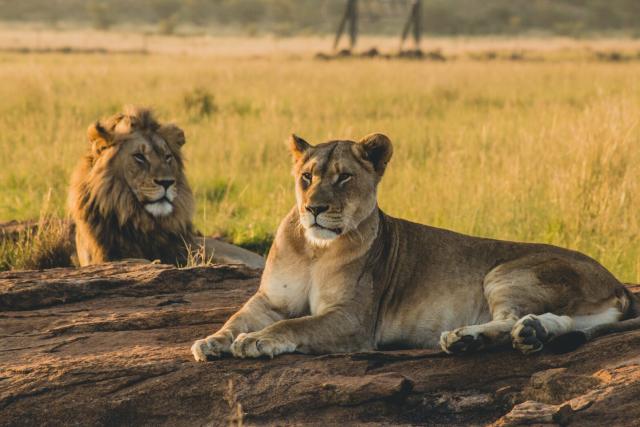In just five minutes of observing African wildlife, you can witness some of the most remarkable scenes in the animal kingdom. Africa’s diverse ecosystems, ranging from savannas and grasslands to wetlands and forests, are home to an astounding array of species that have adapted to life in some of the planet’s most dynamic environments. Whether it’s the sight of a lion stalking its prey, a herd of elephants crossing the plains, or the chorus of birds greeting the sunrise, these fleeting moments provide a window into the intricacies of survival, beauty, and the interconnectedness of life in the wild.
The Serengeti: Nature’s Theater
Imagine standing in the Serengeti in Tanzania at dawn. The sky is painted with soft shades of pink and orange as the sun begins to rise over the vast savanna. In the distance, you see a lone lioness crouching in the tall grass, her golden coat blending seamlessly with the landscape. She’s on the hunt, carefully stalking a herd of zebras grazing nearby. Each second feels suspended in time as she inches closer, driven by hunger and instinct. But the zebras, ever-vigilant, suddenly become aware of her presence and bolt away, their black-and-white stripes flickering in the morning light. The hunt, for now, is over, but this moment offers a glimpse of the constant cycle of predator and prey that defines life in the African wilderness.

Elephants: Gentle Giants on the Move
A few minutes later, your attention shifts to a family of elephants moving across the plains. Led by the matriarch, the herd walks in a tight-knit group, with the younger calves protected in the center. Their massive bodies seem almost surreal as they move gracefully, their trunks swaying rhythmically. As they approach a waterhole, the elephants communicate through low-frequency rumbles, too deep for human ears to detect, coordinating their movements. The calves playfully splash in the water, while the adults drink and bathe. In this short moment, you witness the strong social bonds that hold elephant herds together, as well as their dependence on the land for survival.

The Great Migration: A Timeless Journey
If you are fortunate enough to visit during the annual Great Migration, you might witness one of the most astonishing spectacles of African wildlife. Over a million wildebeest, along with hundreds of thousands of zebras and gazelles, move in vast herds across the Serengeti and Maasai Mara, searching for fresh grazing lands. In just five minutes, you could see thousands of animals on the move, their sheer numbers stretching to the horizon. This epic migration is driven by ancient instincts and the need to follow the rains, a testament to the resilience and determination of these species in the face of challenging environments.

The Smaller Creatures: A Hidden World
Not all of Africa’s wildlife is large and imposing. In five minutes, you might also notice the smaller inhabitants of the bush. A dung beetle, rolling its precious cargo across the sandy ground, symbolizes nature’s recycling process. Nearby, a colony of ants works tirelessly, carrying leaves and food back to their nest. Overhead, a lilac-breasted roller—a brilliantly colored bird—swoops down to catch an insect in mid-air. Even the smallest creatures play crucial roles in maintaining the balance of ecosystems, contributing to the rich biodiversity that defines Africa.

The Sounds of the Wild
While your eyes take in the sights, your ears are filled with the sounds of the African wilderness. Birds sing from the treetops, their calls varied and melodic. In the distance, the deep roar of a lion reverberates through the air, asserting dominance over its territory. The trumpeting of an elephant echoes across the savanna, followed by the laughter of hyenas preparing for a night of scavenging. In just a few minutes, these sounds tell a story of life, survival, and the constant struggle for dominance and harmony in the wild.

Conclusion
Five minutes in the African wilderness can provide a powerful, condensed snapshot of the natural world’s beauty and complexity. Every moment is filled with life and movement, from the majestic elephants and roaring lions to the smaller, often unnoticed creatures that form the foundation of the ecosystem. This short glimpse is enough to leave a lasting impression, reminding us of the interconnectedness of all life and the need to protect these magnificent creatures and their habitats for future generations.



